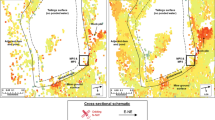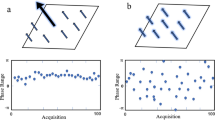Abstract
It has been challenging to detect and differentiate soil slope failures involving rapid movements such as slide and flow in real-time, which result in significant losses of lives and properties. This paper presents an experimental simulation of a sand slope to evaluate the applicability of proposed wireless sensor network (WSN)-inertia measurement unit (IMU) system on characterizing and differentiating slide and flow. Each WSN-IMU sensor consists of three-axis accelerometers and gyroscopes, and five sensors were placed over the slope surface to capture local and global slope failures. A translational slide characterized is confirmed by a combination of low angular velocities within ± 10 deg/s, small changes in gravity accelerations within ± 2 m/s2, and linear accelerations in the longitudinal direction of the slope. The rapid change and intersection of gravitational accelerations at multiple timestamps and a significant increase in an angular velocity suggest a rotational movement. When the angular velocities and gravity accelerations exceed the limits for a translational slide and a significant increase in a linear acceleration of more than 1 m/s2 is experienced, a flow movement associated with the disintegration and fluidization of the slope soil is identified. The agreement on movement behaviors interpreted from the sensor readings and video observations recorded by the pi-cameras supports the application of the proposed WSN-IMU system for monitoring the rapid slide-flow. The promising results from this experimental study provide the foundation for future research and development to apply the proposed WSN-IMU system in a field for landslide monitoring and warning.










Similar content being viewed by others
Availability of data and material
Data will be provided upon requested.
Abbreviations
- Grx:
-
Gravity acceleration in x-axis (m/s2);
- Gry:
-
Gravity acceleration in y-axis (m/s2);
- Grz:
-
Gravity acceleration in z-axis (m/s2);
- Gx:
-
Angular velocity in x-axis (deg/s);
- Gy:
-
Angular velocity in y-axis (deg/s);
- Gz:
-
Angular velocity in z-axis (deg/s);
- Lx:
-
Linear acceleration in x-axis (m/s2);
- Ly:
-
Linear acceleration in y-axis (m/s2);
- Lz:
-
Linear acceleration in z-axis (m/s2); and
- S01–S05:
-
Sensor IDs for five BNO055 sensor devices
References
Avelar AS, Netto ALC, Lacerda WA, Becker LB, Mendonça MB (2013) Mechanisms of the recent catastrophic landslides in the mountainous range of Rio de Janeiro, Brazil. Landslide Sci Pract 4:265–270
Azzam R, Arnhardt C, Fernandez-Steeger TM (2010) Monitoring and early warning of slope instabilities and deformations by sensor fusion in self-organized wireless ad-hoc sensor networks. J Southeast Asian Appl Geol 2(3):163–169
Barla M, Antolini F (2016) An integrated methodology for landslides’ early warning systems. Landslides 13(2):215–228
Carlà T, Farina P, Intrieri E, Ketizmen H, Casagli N (2018) Integration of ground-based radar and satellite InSAR data for the analysis of an unexpected slope failure in an open-pit mine. Eng Geol 235:39–52
Chueasamat A, Hori T, Saito H, Sato T, Kohgo Y (2018) Experimental tests of slope failure due to rainfalls using 1g physical slope models. Soils Found 58:290–305
Cruden DM, Varnes DJ (1996) Landslides: investigation and mitigation. Chapter 3-Landslide types and processes. Transportation Research Board Special Report 247, pp 36–75
Denlinger RP, Iverson RM (2001) Flow of variably fluidized granular masses across three-dimensional terrain 2. Numerical predictions and experimental tests. J Geophys Res 106:553–566
Fan XM, Xu Q, Zhang ZY, Meng DS, Tang R (2009) The genetic mechanism of a translational landslide. Bull Eng Geol Env 68(2):231–244
Giri P (2018) Landslide monitoring and warning using wireless sensor network system. Ph.D. Dissertation, University of Wyoming, Laramie, Wyoming
Giri P, Ng KW, Phillips W (2018) Laboratory simulation to monitor and understand translational soil slides using wireless IMU sensors. Landslides 15(12):2437–2447
Giri P, Ng KW, Phillips W (2019) Wireless sensor network system for landslide monitoring and warning. IEEE Trans Instrum Meas 68(4):1210–1220
Giri P, Ng KW, Phillips W (2020) Assessment of three wireless sensor network-inertia measurement unit devices for landslide monitoring. In: Proceedings of geocongress 2020, geotechnical special publication no. 316, ASCE, February 25–28, Minnesota, MN, pp 10–19
Highland LM (2012) Landslides in Colorado, USA: impacts and loss estimation for 2010. Open-File Report 2012–1204, US Geological Survey, Reston, Virginia, 49 p. https://pubs.usgs.gov/of/2012/1204/OF12-1204.pdf
Iverson RM, Logan M, Lahusen RG, Berti M (2010) The perfect debris flow? Aggregated results from 28 large-scale experiments. J Geophys Res 115:1–29
Iverson RM, Reid ME, Logan M, LaHusen RG, Godt JW, Gridwold JP (2011) Positive feedback and momentum growth during debris-flow entrainment of wet bed sediment. Nat Geosci 4:116–121
Kang Y, Zhao C, Zhang Q, Lu Z, Li B (2017) Application of InSAR techniques to an analysis of the Guanling landslide. Remote Sens 9(10):1046
Keaton JR, Wartman J, Montgomery DR (2014) The 22 March 2014 Oso Landslide, Snohomish County, Washington, GEER, 228, Washington, USA
Lee HC, Ke KH, Fang YM, Lee BJ, Chan TC (2017) Open-source wireless sensor system for long-term monitoring of slope movement. IEEE Trans Instrum Meas 66(4):767–776
Luo L, Ma W, Zhang Z, Zhuang Y, Zhang Y, Yang J, Cao X, Liang S, Mu Y (2017) Freeze/Thaw-induced deformation monitoring and assessment of the slope in permafrost based on terrestrial laser scanner and GNSS. Remote Sens 9(3):198
Major JJ, Iverson RM (1999) Debris flow deposition: Effects of pore fluid pressure and friction concentrated at flow margins. Geol Soc Am Bull 111:1424–1434
Mokarram M, Zarei AR (2018) Landslide susceptibility mapping using fuzzy-AHP. Geotech Geol Eng 36:3931–3943
Ni X, Ye B, Ye G, Zhang F (2020) Unique determination of cyclic instability state in flow liquefaction of sand. Marine Georesour Geotechnol. https://doi.org/10.1080/1064119X.2020.1791289
Ooi GL, Wang YH, Tan PS, So CF, Leung ML, Li X, Lok KH (2014) An instrumented flume to characterize the initiation features of flow landslides. Geotech Test J 37(5):748–768
Park MC (2016) Behavior analysis by model slope experiment of artificial rainfall. Nat Hazard 16:789–800
Ramesh MV (2014) Design, development, and deployment of a wireless sensor network for detection of landslides. Ad Hoc Netw 13:2–18
Savvaidis PD (2003) Existing landslide monitoring systems and techniques. In: Proceedings of the conference from stars to earth and culture, in honor of the memory of professor Alexandros Tsioumis, Thessaloniki, Greece: The Aristotle University of Thessaloniki, pp 242–258
Shakoor A, Tinsley R (2006) A case study of a translational landslide along Pennsylvania Turnpike, USA. In: Proceedings of 10th IAEG congress, the geological society of London, London, UK, p 608
Shala U, Rodriguez A (2011) Indoor positioning using sensor fusion in Android devices. School of health and society, Department Computer Science, Kristianstad University, Sweden, p 51
Smarsly K, Doycheva K, König M (2012) Monitoring of slope movements coupling autonomous wireless sensor networks and web services. In: Proceedings of the first international conference on performance-based life-cycle structural engineering, December 5, Hong Kong, China, pp. 1–7
Smarsly K, Georgieva K, König M (2014) An internet-enabled wireless multi-sensor system for continuous monitoring of landslide processes. Int J Eng Technol 6(6):520–529
Soeters R, Van Westen CJ (1996) Landslides: investigation and mitigation. Chapter 8-Slope instability recognition, analysis, and zonation. Transportation Research Board Special Report 247, Washington, D.C., pp 129–177
Starlino Electronics (2009) A guide to using IMU (Accelerometer and Gyroscope Devices) in embedded applications. http://www.starlino.com/imu_guide.html
Su MB, Chen IH, Liao CH (2009) Using TDR cables and GPS for landslide monitoring in high mountain area. J Geotech Geoenviron Eng 135(8):1113–1121
Terzis A, Anandarajah A, Moore K, Wang IJ (2006) Slip surface localization in wireless sensor networks for landslide protection. In: Proceedings of information processing in sensor network, Aoril 19–21, Nashville, TN, pp 109–116
Tran DT, Dinh CN, Duc NT, Duc TT (2015) Development of a rainfall-triggered landslide system using wireless accelerometer network. Int J Adv Comput Technol 7(5):1–14
Varnes DJ (1978) Slope movement types and processes. Special Report 176, Transportation Research Board, Washington D.C., pp 11–33
Wang HB, Yan F, Li XC, Mi ZJ, Li XM, Wang SQ (2020) Evolution mechanism study of flow slide catastrophes in large waste dumps at the Nanfen iron mine. Bull Eng Geol Env 79:4733–4747
Zheng YC, Setan H, Othman R (2009) LandSMS: Web-based Deformation Monitoring System. In: Proceedings of international symposium and exhibition on geoinformation 2009, August 10–11, Kuala Lumpur, Malaysia, pp 1–8
Acknowledgements
Special thanks to Intelligent Wireless Sensor Network (IWSN), Inc. for their collaboration with the UW research team in the design and development of the wireless sensor network system and the imbedded software for hazard monitoring and warning.
Funding
The authors would like to express their gratitude to the University of Wyoming Tier I Engineering Initiative for funding this research study.
Author information
Authors and Affiliations
Contributions
All authors have reviewed and approved this manuscript.
Corresponding author
Ethics declarations
Conflict of interest
The authors do not have any conflict of interest.
Additional information
Publisher's Note
Springer Nature remains neutral with regard to jurisdictional claims in published maps and institutional affiliations.
Rights and permissions
About this article
Cite this article
Giri, P., Ng, K. & Phillips, W. Monitoring Soil Slide-Flow Using Wireless Sensor Network-Inertial Measurement Unit System. Geotech Geol Eng 40, 367–381 (2022). https://doi.org/10.1007/s10706-021-01905-w
Received:
Accepted:
Published:
Issue Date:
DOI: https://doi.org/10.1007/s10706-021-01905-w




